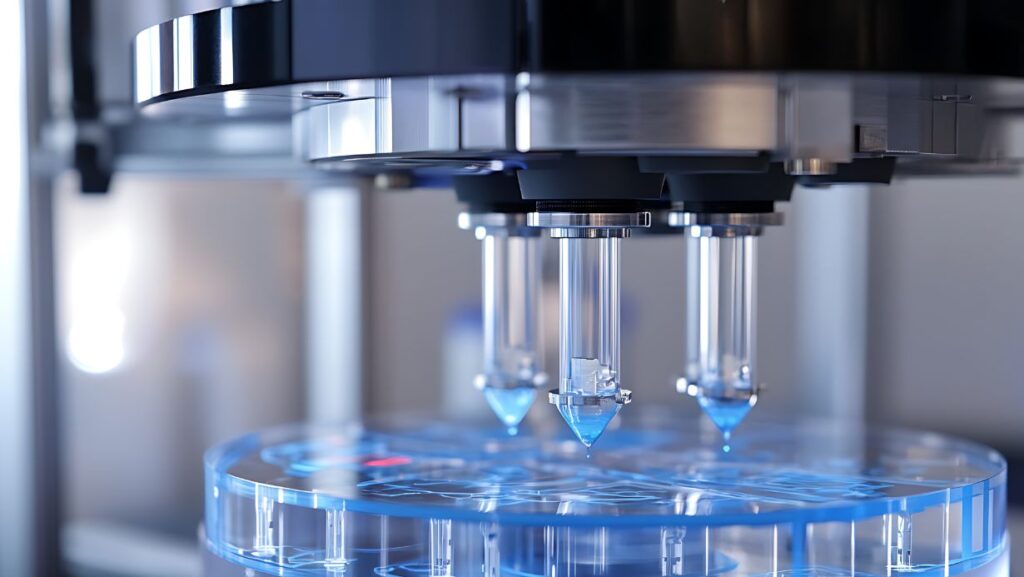Understanding laboratory equipment is essential for research professionals. Modern researchers rely on quality equipment and appropriate materials to ensure accurate results and compliance with laboratory standards. Researchers routinely handle numerous samples across various volumes in daily workflows.
Accurate liquid transfer requires selecting the appropriate pipette type for each application. Quality repeater pipettes are used daily for multiple dispensing operations from a single aspiration. Researchers use them to dispense identical volumes without repeated aspiration, optimizing workflows and reducing physical strain.
Unlike conventional pipettes, repeater pipettes aspirate once and dispense multiple times with consistent accuracy. These pipettes excel in serial dilutions and repetitive dispensing applications. They support reproducibility and maintain uniform sample volumes across all dispenses.
Repeater pipettes reduce variability between samples in high-throughput workflows. Modern technology provides various repeater pipette options for different laboratory needs. Both electronic and manual versions are available depending on application requirements.
Electronic versions are preferred in high-throughput laboratories and for sensitive applications. They feature programmable settings and intuitive interfaces for enhanced workflow control. Repeater pipettes are essential in clinical diagnostics, pharmaceutical manufacturing, and research laboratories.
Selecting the appropriate model for your workflow is critical for optimal performance and data quality.
What is a Repeater Pipette? The Core Concept
Understanding repeater pipette functionality is essential for laboratory professionals. A repeater pipette is a specialized instrument designed for repetitive liquid dispensing. It dispenses the same volume multiple times from a single aspiration of reagent.
This method streamlines routine tasks while maintaining safety and accuracy. These pipettes feature simple operation with powerful aspiration mechanisms for reliable performance. They eliminate repeated aspiration, increasing speed and accuracy while reducing repetitive strain injuries.
A transfer pipette also supports accurate workflows in specific applications. Repeater pipettes are valuable when productivity and consistency are critical for experimental success. These pipettes minimize aspiration errors and improve reproducibility across multiple dispenses.
High-quality repeater pipettes are indispensable for routine liquid handling operations. Here are the main characteristics and advantages:
- Single aspiration, multiple dispenses. The main advantage is a single aspiration followed by multiple dispensing operations. These pipettes excel at repetitive tasks while reducing physical strain on hands and wrists. They’re ideal for plate filling and reagent addition across many samples.
- Flexible volume settings. Repeater pipettes offer either fixed or adjustable volume settings. This provides flexibility across various methods and applications in different research contexts. This design makes them ideal for reproducible high-throughput studies.
- Ergonomic design. Ergonomic design reduces hand and wrist strain during extended use. These pipettes enable high-throughput operations with consistent results throughout the day. Comfortable grips and balanced weight distribution minimize operator fatigue.
- Specialized components. Repeater pipettes are compatible with specialized dispensing syringes. They work with various tip types and materials depending on application needs. Robust construction ensures consistent performance across thousands of dispensing cycles. They minimize reagent waste during routine liquid handling operations.
Electronic Repeater Pipette – The Pinnacle of Precision and Ease
Electronic repeater pipettes represent the pinnacle of dispensing technology. These pipettes deliver enhanced accuracy, precision, and safety compared to manual versions. They combine versatility, automation, and precision in a single instrument.
Digital programming capabilities streamline routine tasks and enhance workflow efficiency. Unlike manual versions, electronic repeater pipettes offer multiple programmable modes for different applications. Key features include programmable protocols, motorized dispensing, and user-friendly operation interfaces.
These features significantly improve productivity in repetitive workflows. Electronic versions are ideal for high-throughput laboratories with demanding sample processing needs. Labs with automated workflows benefit most from electronic repeater pipettes.
These environments demand maximum accuracy, precision, and regulatory compliance. Electronic repeater pipettes reduce manual intervention and multitasking demands on researchers. This allows researchers to focus on critical experimental details rather than repetitive tasks.
Electronic versions provide optimal performance with minimal user fatigue. Here are the key advantages of electronic repeater pipettes:
- Programmable settings. Electronic repeater pipettes allow rapid volume adjustment and protocol storage. Programmable settings significantly reduce setup time for routine protocols. Users can save multiple protocols for instant recall during daily operations.
- Reduced hand fatigue. Motorized operation eliminates repetitive thumb pressing during dispensing. This reduces the risk of repetitive strain injuries during extended pipetting sessions. Researchers can perform hundreds of dispenses without physical discomfort.
- Improved reproducibility. Electronic control delivers consistent volumes across all dispenses. Motorized dispensing eliminates human variability and technique-dependent errors that affect accuracy. This ensures data reliability and experimental reproducibility.
- Memory functions. Protocol storage allows instant recall of frequently used dispensing programs. This eliminates manual reprogramming for routine applications and saves valuable time. Multiple protocols can be stored for different assays and applications.
- Enhanced compatibility. Electronic repeater pipettes work with various syringe sizes and tip types. This versatility makes them suitable for diverse laboratory applications and sample types. Broad compatibility expands application possibilities while maintaining reliable performance across different reagents.
Repeater vs. Multi-Channel Pipette – Understanding the Tools
Multi-pipette dispensers are commonly used for high-throughput research. These instruments play a significant role in modern laboratory workflows. They enable efficient sample processing across various research applications.
Multi-channel pipettes are indispensable for the simultaneous processing of multiple samples. However, they differ significantly from repeater pipettes in design and application. Understanding these key differences helps researchers select the optimal tool for their needs.
The right choice ensures reliable results and accurate volume delivery. Here’s a detailed comparison:
Repeater pipette:
- Aspirates once and dispenses multiple times sequentially
- Ideal for filling various wells with the same reagent
- Best for dispensing identical volumes into multiple tubes or wells
- Available in both manual and electronic versions
- Popular for repetitive tasks requiring uniform volume delivery across many dispensers
Multi-dispenser pipette:
- Uses multiple channels with individual tips for parallel dispensing
- Best for dispensing into multiple wells simultaneously
- Typically available in 8- or 12-channel configurations for microplate formats
- Designed specifically for microplate applications and high-throughput screening
- Provides speed advantage through parallel dispensing of multiple samples
Repeater pipettes work serially, dispensing one well at a time. Multi-pipette dispensers work in parallel, making them faster for microplate applications. However, they’re less flexible for non-standard vessel formats and tube sizes.
Key Applications for Repeater Pipettes
Various instruments support laboratory workflows daily. Stability, repeatability, and safety are crucial for quality results in any research setting. Quality repetitive pipettes maintain stability and consistency throughout operations.
Repeater pipettes are valuable in workflows involving repetitive sample processing. Common applications include processing multiple samples or adding reagents to many wells. These pipettes maintain both speed and accuracy while improving reproducibility.

They significantly reduce time per dispensing cycle compared to conventional pipetting methods. They’re essential in regulated environments and large-scale operations requiring documentation. Here are the main applications where repeater pipettes excel:
- ELISA assays. Repeater pipettes efficiently dispense substrates, antibodies, and wash buffers. They’re ideal for adding reagents to multiple ELISA plate wells with consistent volumes. This ensures uniform coating and reduces assay variability across plates.
- Serial dilutions. Repetitive pipettes are essential for serial dilution workflows in research and diagnostics. They ensure equal volume dispensing across stepwise dilution series for standard curves. Precision is critical in these applications for accurate quantification.
- Cell culture. Researchers use repeater pipettes for routine cell culture maintenance. They efficiently add media or buffers to multiple culture vessels simultaneously. This speeds up routine cell feeding and passage procedures significantly.
- Clinical diagnostics. In clinical diagnostics, repeater pipettes ensure accuracy and consistency. They enable routine dispensing across many samples with minimal variation. This is critical for patient sample testing and quality control procedures.
- Pharmaceutical and biotechnology. Repetitive pipettes are indispensable in pharmaceutical and biotechnology workflows. They support standardized, repetitive liquid handling steps in manufacturing processes. This ensures quality control and regulatory compliance with validated protocols.
Choosing the Best Repeater Pipette
Selecting the appropriate repeater pipette directly impacts accuracy and workflow efficiency. Various repeater pipette models suit different workflow requirements and laboratory settings. Selection should consider sample types, volumes, and throughput requirements carefully.
Consider these factors when selecting the best pipette for your laboratory:
- Manual vs. electronic. Electronic models suit high-throughput tasks requiring programmability and precision. Manual versions are cost-effective for routine use with moderate throughput demands. Evaluate your daily workload and budget when deciding between options.
- Volume range. Evaluate volume ranges to ensure the model covers your typical dispensing needs. Choose a model with appropriate minimum and maximum volume capabilities. This ensures accuracy across your most common applications.
- Compatibility. Verify compatibility with available syringe and tip systems in your laboratory. Proprietary systems may limit flexibility, while universal compatibility offers more options. Consider consumable costs and availability when evaluating compatibility.
- Ergonomics. Choose ergonomically designed models to minimize hand and wrist fatigue. Comfortable grips, balanced weight, and smooth operation reduce strain during extended use. Test the best pipette if possible before committing to purchase.
- Advanced features. Advanced models offer programmable protocols and memory storage for frequent applications. Dispense counting features track progress and improve efficiency in repetitive tasks. Consider whether these features justify the additional cost for your applications.


